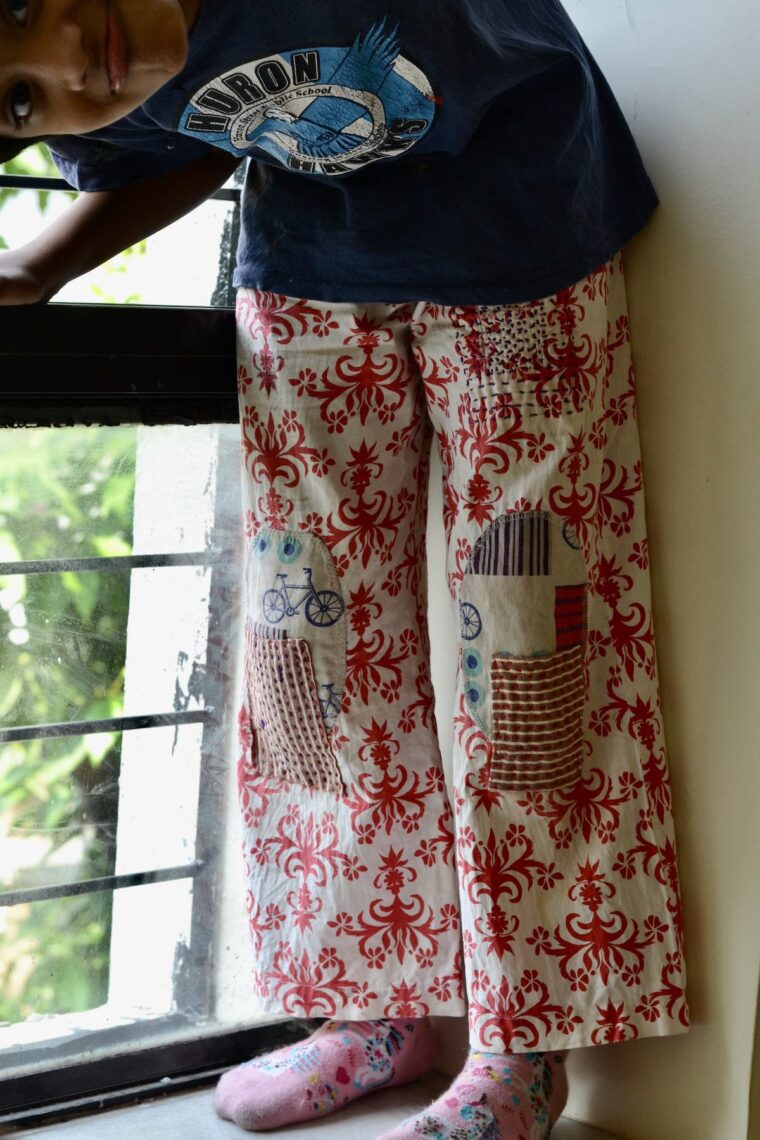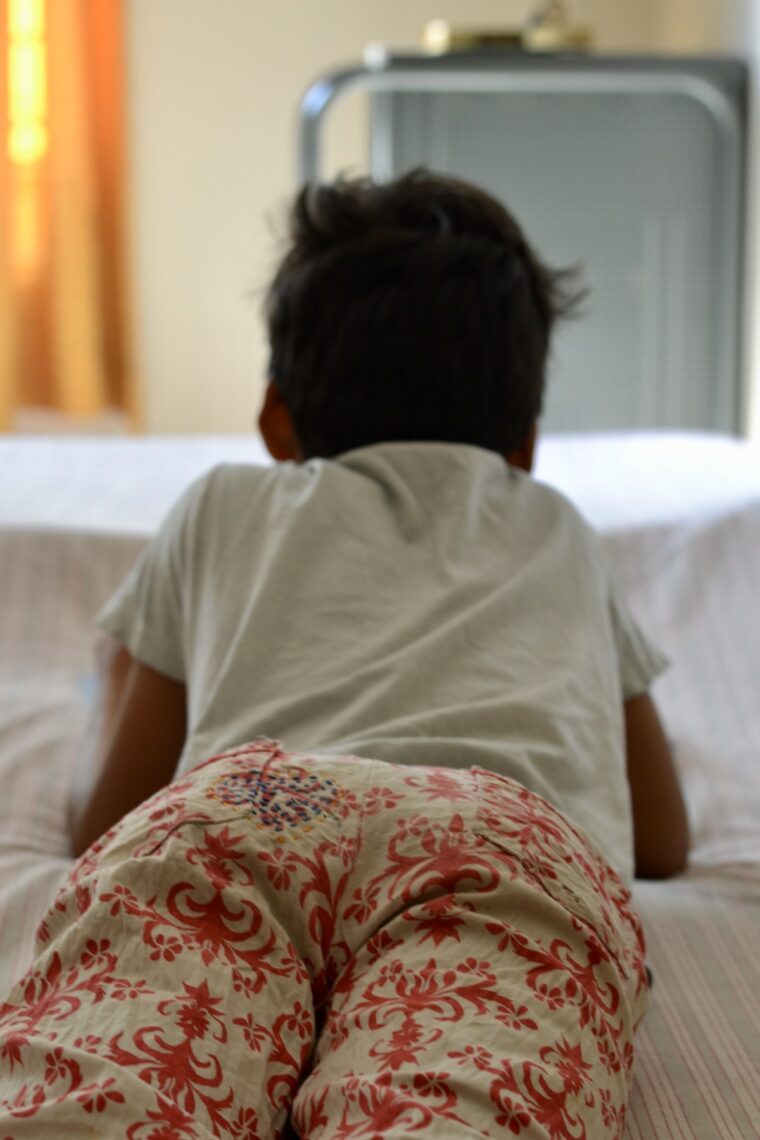We have a fantastic post for our series, Sewn Stories, which is all about the garments or textiles that have meant the most in your life, either sewn by you or by someone else. Asmita, a member of the Advisor’s Circle, is sharing her mending journey. The pictures of her visible mending are beautiful and inspiring. Now I’ll hand it over to Asmita.
I think it would be great to tell a story of my mending journey as something that I stumbled into accidentally, only to fall in love at the first attempt, followed by how I have never looked back since then. That, however, would be pretty far from truth. The real story goes something like this:
So let me start at the beginning. I have been sewing clothes first for my kids and then for myself for the last decade or so. During these years, I was happily experimenting with different patterns, hacking some, using some patterns on repeat, while also getting adventurous in terms of the patterns from which I was sewing for myself. In most cases, re-visiting a sewn garment meant putting in a new button or in the case of my children’s clothes letting down a hem or putting in new elastic. Often times, I have a small embroidery project on the side, but this is as far as my hand sewing prowess goes. Nothing of the above is mending, which as far as I can tell, is far more intense; it is work which requires some dedication and (I am sure one will agree) a fair bit of motivation. At some point during the last two years when we were all at home, my son demanded that I repair his clothes that he was already wearing and that he liked. In other words, the brief was concise: he didn’t want new clothes to be made, he wanted them mended. And, if I wasn’t willing to mend them, he was happy to wear them torn, but he wasn’t willing to trade his loved soft and worn clothes for new ones.



Around the same time, two things happened. One, I read Mending Matters: Stitch, Patch and Repair your Favourite Denim and More by Katrina Rodobaugh. And two, the then recently made Sandbox Pants and Field Trip Cargo Pants with sewn knee patches had, in less than two months, worn out in the knees. Fortuitously (and I say that because that’s how I began my mending journey) by the time I finished reading her book, I had pants to try out my skills on.
My first bits of mending did not begin with any grand plan. The patches I used then (and still prefer to use) are usually fabrics from the scrap bin. My son loves to rummage through what I have and chooses what fancies him at that moment. The thread I use is also nothing special; mostly, it is old embroidery thread. He likes colour and mixing of prints, and so I rarely use matching thread. Sometimes there is a very specific request: for example, when the pants tore on the seat, he requested sewing a “heart†in its place.


Sometimes I will also use the decorative stitches on my machine (most of which I admit, I used for the first time only after he started to ask me to mend). I still haven’t done a whole lot of mending for adult clothing, so when my father requested some repair work for his jeans a few months ago I was quite pleased. I used rough white thread which ties together the ironed clothes (as they come back from the istriwala –ironing man/lady), along with some fabric from my son’s pants. I was told later that my father’s friends found it quite intriguing. I also then repaired my own rtw top which I have loved but which was falling apart using some old saree blouses belonging to my grandmother.


I will be the first to admit—quite a bit of my hand sewing is far from perfect. In fact, most of it is wonky, some done in hurry depending on how long I have procrastinated, and some with a certain design plan in mind. No matter which one it is, I am always amazed by how pleased my son is to receive his old but freshly mended pants. I have often asked him what he loves about them, and the answer is always the same—they are soft and worn is what he says, and I guess what helps is that they carry the love and mark of all his adventures, both new and old!



The red ikat one is a particular favourite, and perhaps the most heavily mended. Additionally, the fabric has also frayed so they tend to tear in the oddest places. About two months ago, when they were due for a mend in the inner thigh area, I suggested we “retire†them as the pants were “on their last legs.†He requested one last mend but liked that phrase and stuck to it. The pants were re-named as the “last leg†pants! A few weeks ago, rather unsurprisingly they tore again, this time on the seat and where the knee pads had been patched already. We consulted again. When I referred to them as the “last leg†pants I was told that in the interim there had been a re-naming – they are now “ghost†pants, because they have “died†already! But yes, could I please repair them? And so here, we go, and this is how they look in their afterlife.

Despite his unbridled enthusiasm, I would be lying if I were to say that I greet all mending with the same zeal that I approach sewing new clothes with. After all, who is not lured by new fabric, pattern and thus a new adventure. Not to mention, there is also an unspoken demand from others around us that we wear (or specifically, I put on my children) un-patched, un-mended (in any kind of obvious way at least) new looking clothes. The Indian middle classes are presently exploding with a newly found consumerism. Fabric has always been relatively cheap (the roots of which lie in our colonial history). Now there are multinational brands literally pouring in with new fashion at low prices to please the masses. For long, especially in my parents’ generation and mine too, there was a tendency to make do. Until recently, Indian middle class only brought clothes twice a year, and the Singer sewing machine was ubiquitous. Tailors still exist, but the demand for fast fashion and new clothing has never been higher. In such an environment, it is considered slightly odd, and almost shameful to dress your child in old patched up clothes, and it is not unusual when a close relative will give him clothes as gifts with the hope that he stops wearing what he loves.
My son’s demand to return to the same fabric, same clothing and repair work again and again is seen to go against the grain. I find myself struggling often to start mending work: both due to the aforementioned pressure coupled with my own laziness. In the language of mindfulness, I will admit that my mending “muscle†is not a strong one, but the more I mend the more I recognise how much I need to do it. The obvious advantages of it are sustainability (cloth does not decompose as quickly as one thinks it does, even cotton), but the more hidden pleasure of it is contained in the natural slowness it brings to one’s life—my life. And so as reluctantly as I might start off, there hasn’t been so far even a single instance when I have not found pleasure in the process or have not ended in a happier place than where I started. I know my son thinks sewing is a kind of a superpower I have and many of our conversations centre around sewing/making/building/creating. But truly, I think in mending his clothes, in making me mend his clothes I have received a gift from him of seeing the world in a different way.
(adsbygoogle = window.adsbygoogle || []).push({}); Â
Socks is also a necessity for everyday life. Solid colors and gradient colors are both available. Also there are many patterns or designs, such as ruffle socks, animal printing socks, etc. For different season, we have different thickness baby socks. And usually we choose cotton socks which is breathable, soft and comfortable. But some other materials socks is also a trend now.
Kids Socks:


infant socks,kids socks,kids knee socks,baby ruffle socks
Shenzhen Baby Happy Industrial Co.,Ltd , https://www.bbabyshoes.com
